 | The instructions in this article relate to Ledger Card. The icon may be located on your StrataMax Desktop or found using the StrataMax Search. |
Preview Features
If access has been set for users via Security Setup, this screen can be toggled between the legacy and the new version.
For the individual user, this can be toggled from the Desktop as shown below by clicking on your user name/ Preview Features. Untick Ledger Card to use Report Distribution.
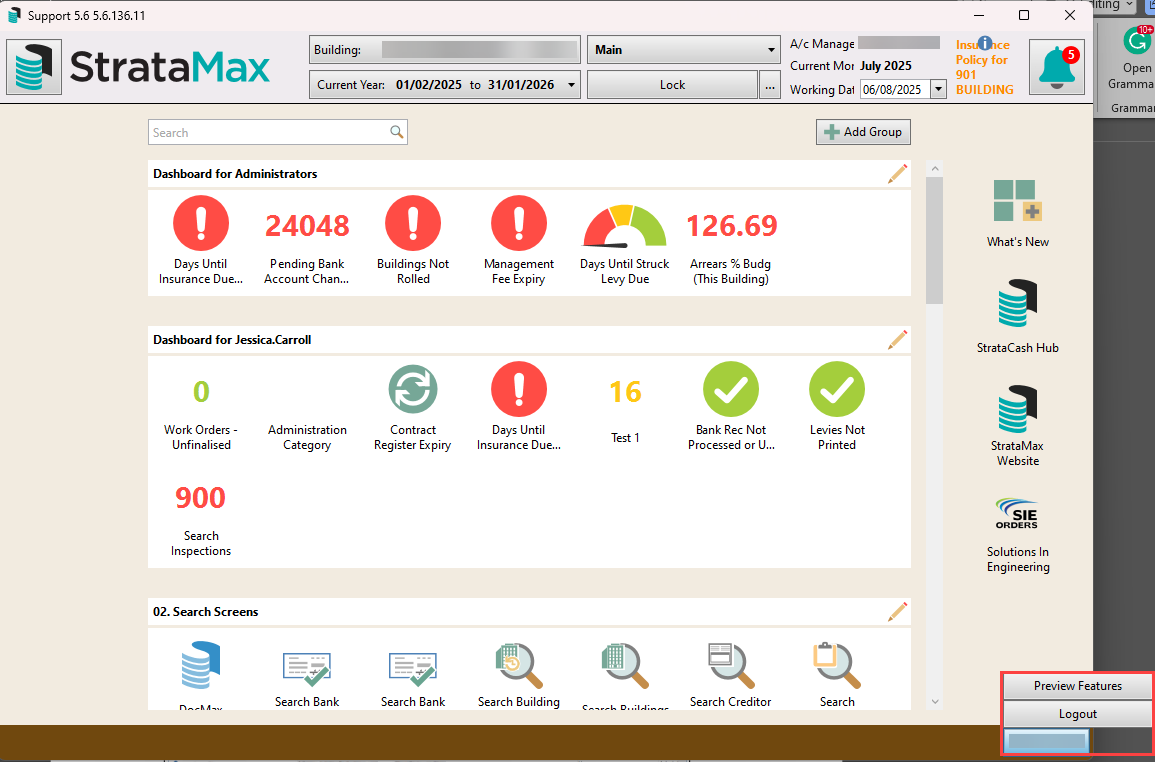
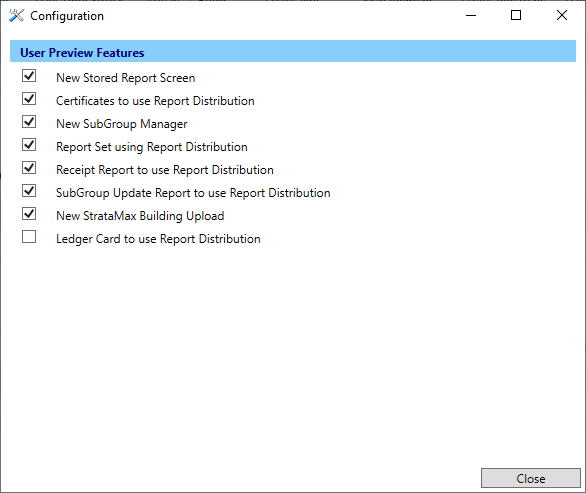
Produce a Ledger Card
The Ledger Card displays a full history of an owners account with details of all debits, receipts and discounts. It is very useful for reconciling any disputes or tracking entry errors. The Ledger Card may be issued to owners or to search agents. A Ledger Card can be produced for the current month, old year, or current year to date or from last zero balance for all lot accounts or selected lot accounts. If you need to adjust the Interest Calculation Date, this option is available and accessed from the Configuration Cog Wheel.
By default, the Ledger Card prints with a deposit slip so owners can make payment.
- Search or select Ledger Card.
- Tag the account required by clicking on the ... ellipse to select the Accounts, click the Magnifying or tick next to the Account to print a separate ledger card for.
- Click the configuration cog wheel to review the Configuration - this is where you can set the Style - Year to date, or Month to date, From last zero balance, Selected month, Year to date - include old year or All History to include all historical year data. The Date for interest calculation (Blank for Today) can be set for settlement here in the Configuration.
- Include any additional Reports or Attachment if required.
- Click the magnifying glass to preview the report or click Proceed.

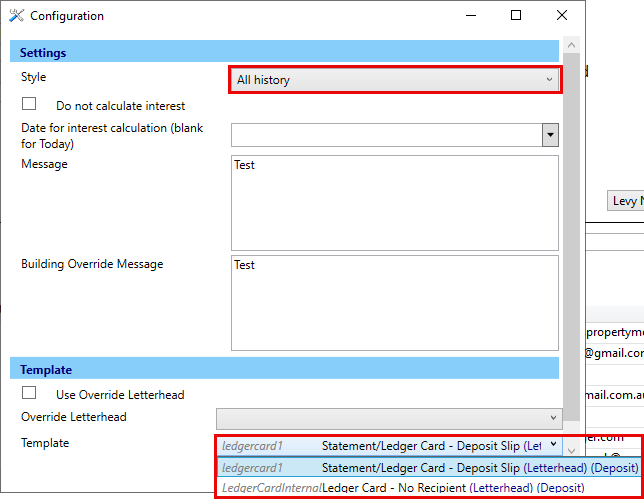
Ledger Card Internal Template
There is the option to change the Ledger Card Template to remove the Owners details, this may assist with producing ledger reports for a Lost Building or including with a Certificate. The following will be available on the Ledger Card Internal template:
• Name and Address will not display on the new template.
• Lot and Unit number will display.
- Search or select Ledger Card.
- Tag the account required by clicking on the ... ellipse to select the Accounts, click the Magnifying or tick next to the Account to print a separate ledger card for.
- Click the configuration cog wheel to review the Configuration - this is where you can can set the Template, Ledger Card - No Recipient.
- Click Close and Proceed.

Any additional configurations such as the Interest Calculation Date or the Deposit Slip can be adjusted by reverting to the Legacy Ledger Card using Preview Features.
Legacy Ledger Card
To revert to the Legacy Ledger Card style, access Preview Features and adjust the setting Ledger Card to use Report Distribution.
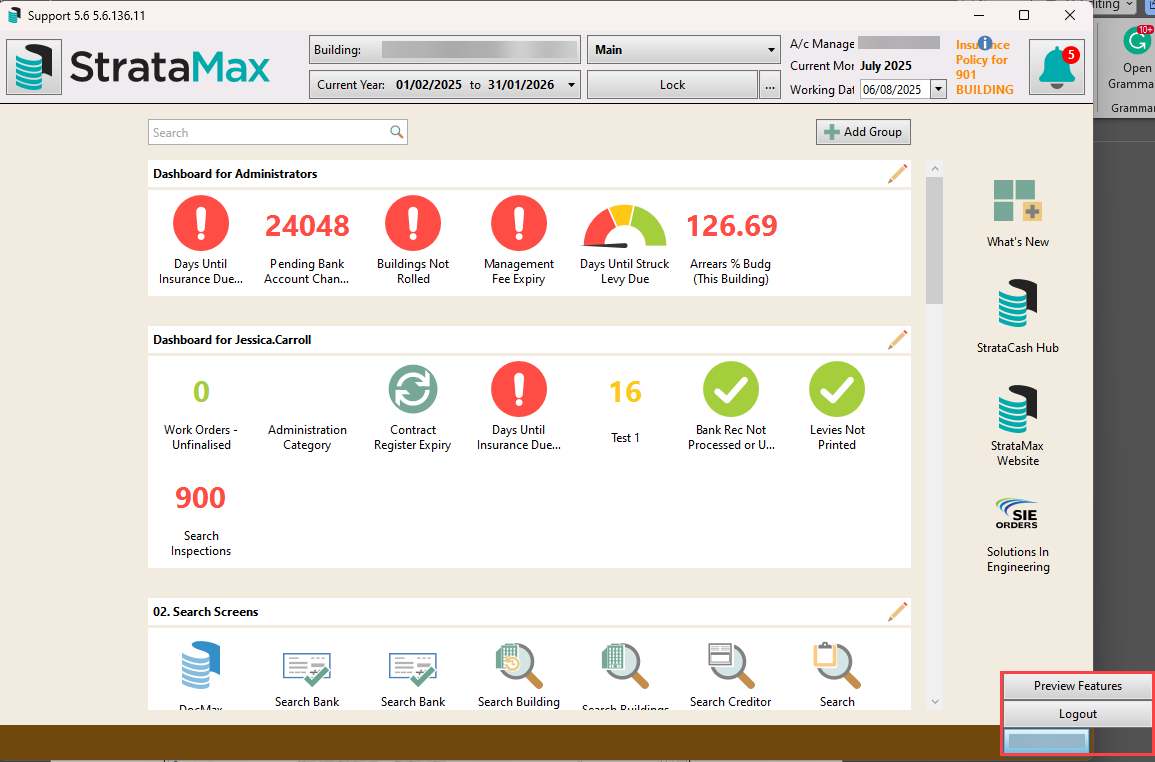
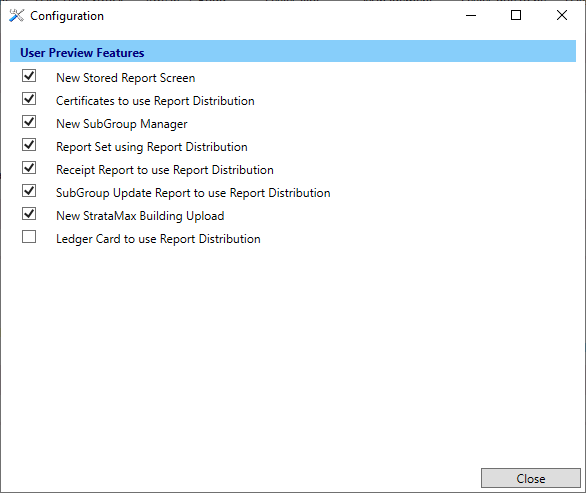
This screen also contains the Owner Tax Year Report, which reports the history of an owners account with details of all charges and receipts.
Different templates will display based on whether Ledger Card or Ledger Report is selected from the Options menu - this is a user setting.

Ledger Card & Report | Templates
The ledger cards can be configured to use certain templates. Instead of having to test each levy template, here is a PDF with the ledger card templates available, for your convenience: Ledger Card Templates.pdf
- Click the ellipsis button next to the Template field in the top right of the Ledger Card screen.

- In the Template Selection screen, select the template required, and either click the Select as Global button to use the template for all buildings, or click Select as Local to use this template for the current building only.
- If you would like to preview the template first, select the template, then click the Preview button at the bottom.
- To change the preview style, click Options > Preview Style > Field Names or Field Numbers.
- Make sure you select the Deposit in the bottom section of the screen, and click the Select as Global button.
- Click Close to close the Template Selection screen.
Ledger Card & Report | Configuration
Address Preferences (Global Setting)
Displays a drop-down menu to select either the owner's Residential/Service Address or the Levy Notice Address when sending Ledger Cards or Ledger Reports.
Use Local Paper Source for Deposits (User Setting)
This box is ticked by default and it's recommended that it not be removed as it may adversely affect printing ledger card when using StrataMax on a remote desktop/server.
Always show last active global message (User Setting)
This should be ticked if the ledger card/report template being used has a Global message that is currently active under the Message tab.

Ledger Card | Tools
Edit Legal Action Words
This will change the wording on the ledger card when the owner is placed in legal action. Where the legal action words are placed will depend on the template that is being used for the ledger card. The wording is also limited to 30 characters, including spaces.
Edit Due Date Words
This will change the date or wording on the ledger card's deposit slip in the bottom right, provided a template with a deposit slip is being used.
Owner's Tax Year Report Setup
Please see the Owner's Tax Year Report Preferences section.
Produce a Ledger Card
The Ledger Card displays a full history of an owners account with details of all debits, receipts and discounts. It is very useful for reconciling any disputes or tracking entry errors. Since the Ledger Card is in a presentable format it may be issued to owners or to search agents. A Ledger Card can be produced for the current month, old year, or current year to date for all lot accounts or selected lot accounts.
By default, the Ledger Card prints with a deposit slip so owners can make payment. This can be changed by clicking Options > Ledger Report.
If the deposit slip is not displayed at the bottom of the ledger, it could be that Ledger Report is currently selected in the Options menu. Click Options > Ledger Card to fix this.
If the property charges interest on unpaid levies (i.e. the Building Information field Overdue Levy Interest Rate has a number greater than 0.00) and you are preparing a lot account for settlement, a setting can be used so that the interest calculation amount appears on the Ledger Card.
- Search or select Ledger Card.
- Tag each of the accounts to print a separate ledger card for.
- Click Proceed.
Produce a Ledger Report
The Ledger Report produces the same information as a Ledger Card. The difference is the inclusion of the Deposit Slip on a Ledger Card. By default, the Ledger Report produces a Ledger Card with no Deposit Slip and fits more information on each page. If this is the last selected report type, remember to change the option back to Ledger Card. If the deposit slip is reporting on the ledger and you would like to remove this, select Ledger Report under the Options menu.
The tabs for the Ledger Report are the same for Ledger Card. See below for details on the Message and Conditions tabs.
- Search or select Ledger Card.
- Click Options >Ledger Report.
- Tag each of the accounts to print a separate ledger report for.
- Click Proceed.
Ledger Card/Report | Conditions
- Search or select Ledger Card.
- Click the Message tab, this will display any messages that will report on the Ledger Card. Ensure that you select the Print Message check box so the message will print on the Ledger Card. Message Maker will allow new messages to be created. The Message page will provide further instructions.
- Settings for the ledger card can be set in the Conditions tab.
- In the Transaction Order section choose from:
- Entry: to print the transactions in the order that they were entered into BCMax.
- Date: to print the transactions for this account in date order.
- Reference Number: to print the transactions for this account in reference number order.
- In the Report Order section choose from:
- Account Number: will print the Ledger Card in code number order.
- Alphabetical: will print the Ledger Card in alphabetical name order.
- In the Report Period section choose from:
- Month to Date: to print all transactions for the current month only.
- Year to Date: to print all transactions for the current year.
- Select Month: to print the transactions for the current month only. If this option is selected then you will be able to select the month directly below it.
- Include Last Year: to include any balance owing from the previous financial year on the ledger card. These will show as brought forward balances.
- Set the option No Print Zero Balance to not print any ledger cards for lot accounts whose transactions result in a zero balance.
- Due Days: If the deposit slip is being applied for the Ledger Card this will assist in controlling the due date printed in that area of the deposit slip.
Save these setting as default by clicking the Set as Default button so these settings are saved for every time a ledger card is produced.
- Select the Interest/Links tab by clicking on this heading. Type in the date to calculate interest up until by typing a date into Interest Calculation Date. If there is no interest amount set in building Information in the information field Overdue Levy Interest Rate, then no interest will be calculated. This interest calculation prints on the ledger card, but the entry is not added permanently to the account. If the lot is being settled, type in the expected settlement date. If there is an amount in the Overdue Levy Interest Rate information field and you do not want to calculate interest, then click on 'Do not calculate interest' to mark this option as active.
- Click Proceed.
Owner Tax Year Report
This report is not available for old or historic years and can only be produced for current owners, and the transactions will be for the previous tax year based on the transaction date. New owners will only show from their date of transfer for the previous tax year. We recommend that this report is run immediately after June month end rollover.
This report shows the history of an owner's account with details of all charges and receipts for the previous tax year based on the transaction date.
The Owner's Tax Year Report will allow a charge to be set for payment by the lot owner, as well as creating an additional TRMax record to raise income to the manager. This will occur when the report is emailed or printed, depending on the correspondence settings in the Correspondence Preferences.
Subsequently, it cannot be generated unless you have first set up and linked an income code in GLMax to an expense code in BCMax, and then configured the report to use the correct charge code.
Owner's Tax Year Report | GLMax Invoice Code Setup
First you need to create the Invoice Code, which is done in GLMax, in Edit Invoice List. Please refer to Creating a New Invoice Code for steps on creating a new Invoice Code.
Owner's Tax Year Report | Linking Invoice Code
After the Invoice Code has been created, it needs to be linked to an expense code in BCMax. This is done in GLMax, in Invoice Link Manager. Please refer to Link Account Codes for the required steps.
Owner's Tax Year Report | Default Charge Code
Once you have set up the Invoice Code, and linked the GLMax Income Code to the BCMax Expense Code, you will need to configure the Default Charge Code in BCMax / StrataMax.
- Select the required building, then search or select Ledger Card.
- Click File >Configure.
- Click Report Fee Invoice Code Field.
- Select your Invoice Code that you set up in GLMax (Owner’s Tax Year Report).
- Click OK, then Close.
Owner's Tax Year Report | Owner Preference Setup
Any owner that wishes to receive the Owner’s Tax Year Report must be configured to receive the report in the Owner’s Tax Year Report Setup screen. All lot accounts by default will have ‘Unconfirmed’ in the Send_Tax_Info_Report column, until you manually change it to ‘Yes’ or ‘No’.
- Search or select Ledger Card.
- Click Tools >Owner’s Tax Year Report Setup.
- Highlight the lot accounts you wish to set to receive the report (use the Shift or Ctrl key to multi-select).
- Click the one of the three buttons in the bottom left of the screen:
- Unconfirmed: client preference for receipt of this report is unknown, therefore no report will be produced.
- Yes: the client has confirmed that they wish to receive the report, and has consented to pay the fee.
- No: the client has confirmed that they do not want to receive the report, and this lot will be excluded from any report runs.
- Click Close when complete.
Flag Reset on Change of Ownership: If a change of ownership is completed in the Roll, the Owner’s Tax Report preference will automatically reset to Unconfirmed.
Owner's Tax Year Report | Preference Reporting
To report Owner’s Tax Year Report preferences for all buildings, the Global report, Owner’s Extract can be used.
- Search or select Reports/ Utilities (Global).
- Select Group / Custom Queries.
- Select Buildings and tag as required, then select OK.
- Select Proceed.
- Select Owner Extract from the list.
- Tag required fields to be included.
- Click to Include Owner’s Tax Info Report Setting on the right. When included the button text will say Exclude Owner's Tax Info Report Settings. Toggle between these to include or not include.
- Select OK.
If records for roll types, other than the owner, are extracted (i.e. agent / tenant), the field will report ‘not applicable’ as the Owner Tax Info Report is for the owner only.
Owner's Tax Year Report | Print or Email Report
Although the Owner’s Tax Year Report can be produced individually on an ad-hoc basis if required, it has been designed so that the report can be produced globally for the entire portfolio. If run globally, this feature provides the ability to easily generate the report for all owners in your portfolio that have expressed a preference, and been configured to receive it.
The report will observe the owner's contact preference for correspondence in the Roll, and copies of the report are available for redistribution in Roll.
- Search or select Ledger Card.
- Select Options > Owner’s Tax Year Report.
- Select Change Building and tag all (Ctrl + A).
- Set the printer and printing preferences.
- Click Proceed.
Owner's Tax Year Report | Frequently Asked Questions
These are some of the more frequently asked questions with answers below for scenarios around producing the Owner Tax Year Report.
Can I produce the Owner's Tax Year Report for a prior owner?
No. The report can only be produced for a current owner.
Example:
If the current owner was the owner as at 30th June, this report will be able to be produced as long as they are the owner.
Can I produce the Owner's Tax Year Report for a part year, prior to a change of ownership?
No. The report can only be produced for the full tax year period of 1st of July to 30th of June.
Example:
Ownership changed 15/08; Owner sold 28/04 – report will not be able to be produced.
New owner 28/04, still Owner as at 30/06 – Owner will be able to receive for Ownership period 28/04 – 30/06.
When is the best time to produce the report?
We recommend the report is run in July as soon as June end of month has been completed; this will ensure the report is produced for the current owner before any potential change in ownership are processed.
We took management of the building during the Tax Financial Year; what information will the report produce?
The report will include all charges & receipts dated between 1st of July and 30th of June. Journals are not included in the Charges or Receipts, however will be reported within the Transactions Summary.
Example:
Opening balances to a Lot account will be journals and therefore will not report as charges / receipts but in the transaction summary.
Can owners access the report via the StrataMax Portal?
No. The report can only be produced from BCMax, however the owner can access a Ledger Card or Owner Information Report. This is to avoid owners purchasing the report online when they may have only been an owner for part of the tax year, or trying to purchase the report prior to end of tax year.
Why does the report show discounts separately in the summary?
Discounts are reported separately to highlight the difference between actual money receipted against discounts given.
How do I refund an owner the fee for the report?
Enter a negative TRMax record using the invoice code configured for the charges; ensure charge owner is ticked. Once the TRMax recoveries have been processed, the owner will be refunded and a debit entry against your Managers creditor account posted.

